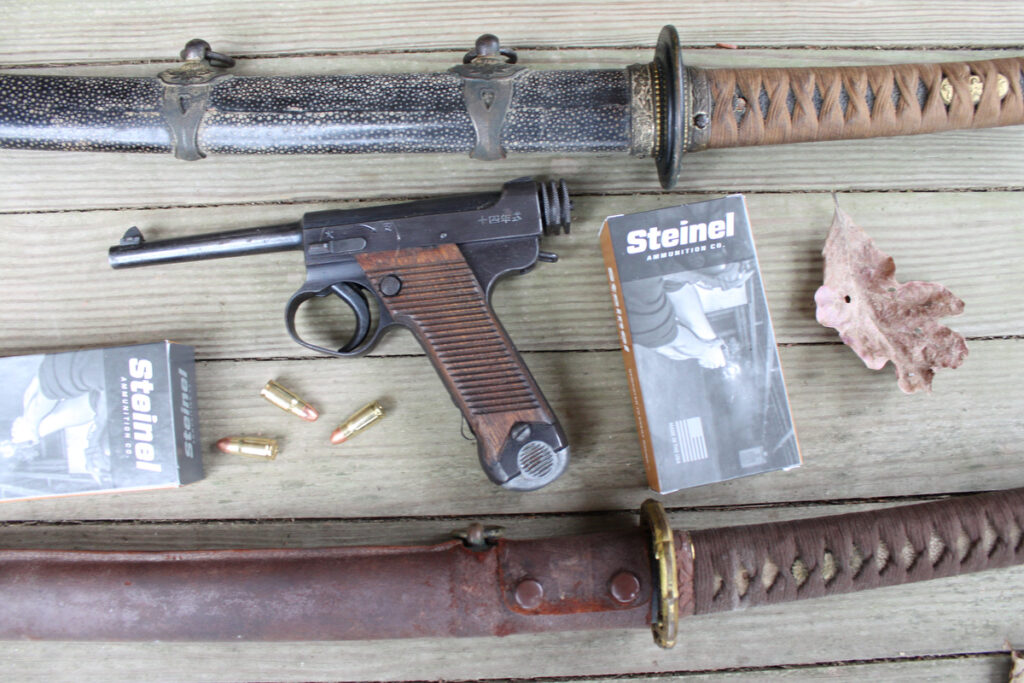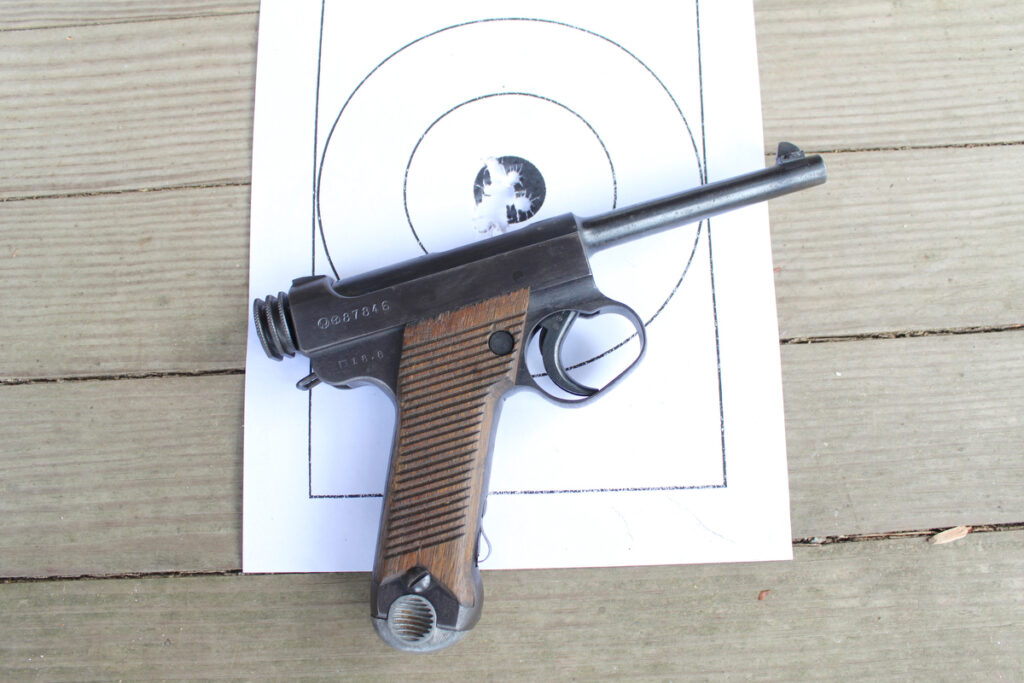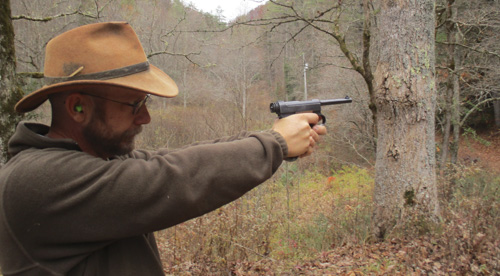By Jim Dickson
The Nambu Type 14 was adopted in 1926 as the service pistol of the Imperial Japanese Army and served as its military sidearm until the Japanese surrender in 1945. It was designated the Type 14 because it was adopted in the 14th year of their current emperor’s reign, 1925. Of the estimated 400,000 Type 14 Nambu pistols made, many found their way home to the U.S. as war trophies of WWII. There they languished as lack of ammo prevented their use. Now, Steinel Ammunition is making 8mm Nambu ammo and I had 100 rounds of it for test firing.

Shooting these pistols is an eye-opening experience. This a super easy-to-hit-with pistol that is fun to shoot. It delivers pinpoint accuracy, easily hitting one-inch targets at 25 yards firing the pistol with one hand, like pistols are supposed to be fired. Recoil is the about the same as a .22 pistol. It points perfectly and hangs steady. Workmanship on all but the late war production guns is flawless, and the gun functions reliably as is expected of a military issue pistol. Trigger pull on the test gun was so perfect that it could not be improved on. The sights were high visibility with the rear sight opening broader at the bottom in order to let in more light in low light conditions.
I also let two other men and one of their wives shoot the Nambu and all three wanted to buy one. I have never had that universal reaction to a gun that I let others fire.
DESIGN CRITERIA
This ease of hitting with the Nambu was a design necessity for the Japanese and Colonel Kijiro Nambu was up to the challenge. The average Japanese officer of the day was not a pistol shooter and he dreamed of cutting down the emperor’s enemies with his samurai sword, not shooting them. In order for him to be effective with a pistol, he had to be given every advantage possible. The Luger pistol was the best pointing pistol of the day, but it had a little more recoil than the Japanese designers wanted. In addition, the Luger’s grip was a bit large for some of the Japanese hands of the period. While the Imperial Naval Marines had a 6-foot minimum height the poor diet of most of the Japanese of this period left a lot of small men as a result. You need good nutrition to grow big.

CALIBER SELECTION
At this time the Japanese were looking toward Europe as a model for their modernization and the 32 ACP was considered a perfectly adequate military and police caliber in Europe in the early 20th Century. A lot of Japanese officers were carrying various private purchase .32 automatics. One big reason for this was the fact that the 32 ACP is the largest pistol caliber that has about the same recoil as a 22 LR making it easy to master. This is why that even today it is the most produced pistol caliber in the world.
The Japanese military felt that their status demanded their own cartridge though, so they developed the .32 caliber 8mm Nambu cartridge which looks like a 30 Luger but performs like a relatively hot loaded 32 ACP. The Steinel ammo, which shoots to the sights of the Nambu perfectly, has an 83-grain FMJ bullet moving at 1040 FPS. Like the 32 ACP FMJ, it is a very good penetrator, and the Japanese military were quite happy with it.

ERGONOMICS
The grip angle of the Luger was copied but the grip was made smaller by the expedient of placing the two recoil springs mounted alongside the bolt and leaving the grip as just a magazine well. Great attention was paid to getting a perfect balance and the final result was a gun that pointed fast and accurately yet had no real recoil to disturb the shooter. This also makes the Nambu the ideal gun for teaching a small child to shoot a pistol. It is certainly not too big being only 32 ounces and 9 inches overall with a 4 3/4-inch barrel.
The magazine is copied from the German Luger, and, like the Luger, its angle causes enough friction that the magazine spring is only 60% efficient, so you have to have a heavier, stronger spring. There is a loading button to pull the follower down for easier loading.
MAGAZINE RETENTION AND OTHER STRANGE FEATURES AND FLAWS
The Japanese lack of expertise with a semi-auto pistol was shown by the fact that the Japanese did not like the magazine coming out easily when the magazine release catch was pushed in on the first model of the Type 14 (which had a smaller, round trigger guard.) Apparently, they were afraid of dropping and possibly losing magazines. So, they added a spring to the front of the grip to retard the magazine from dropping free. Add to this the fact that the bolt is held open by the magazine at the last shot and removal of the magazine can become difficult. I have fired Nambus where magazine removal was not a problem and others where it was.
The first models with the round trigger guard usually do not have a magazine safety while the second model always was fitted with one. In addition, not all the parts interchange. For example, the first model has a long firing pin that stops short of the bolt lock while the second model has a short firing pin that passes through a notch cut into the bolt lock.
The safety is too far forward to be operated by the shooting hand but apparently the Japanese figured your left hand had to be doing something so let it handle the safety.
The most serious flaw is that the pistol can be reassembled and fired without the locking block which could result in damage to both the gun and the shooter. Perhaps the Japanese were too prideful to admit that the emperor’s second lieutenants could do something stupid.

CYCLE OF OPERATION
The operating cycle of the Nambu begins with the chambered cartridge being fired. The bolt is locked firmly in to the barrel extension by the locking block and the recoil drives them all to the rear until the barrel hits the barrel stop where the locking block is cammed down by a cut in the receiver permitting the bolt to continue its journey to the rear alone as it extracts the fired case and pulls it along until the case hits the ejector and is thrown clear of the gun. Upon going back as far as it can go the compressed dual recoil springs begin throwing it forward again where it meets the next cartridge in the magazine which has risen in the space left by the retreating bolt. As it continues forward it drives this cartridge out of the magazine and into the chamber. During this time the locking bolt swings up on its pivot through its slot in the receiver locking into the underside of the bolt as the completed assembly is rammed home. Now the disconnector unblocks the striker, and the pistol will fire at the next pull of the trigger.
TEAR DOWN
Field stripping is relatively easy. Just remember to not put it together without the locking block. Take out the magazine and clear the chamber. Put the safety on fire. Now push the head of the firing pin extension at the rear of the bolt and turn the bolt head to unscrew it. Now the firing pin, firing pin spring, and firing pin extension will come out. Push the muzzle against a hard object until the barrel is forced all the way back holding it there while you push in on the magazine catch and pull the trigger guard straight down and out of its groove in the grip. The barrel and bolt may now be pulled off the front of the receiver. Take the locking block out of its pivot and then the bolt and the 2 recoil springs. Reassemble in reverse order being damn sure you put the locking bolt back in.
VARIATIONS
While the type 14 is the most common version of the Nambu it was not the first. In about 1904 Colonel Nambu came out with the first of his pistols which was not adopted but was sold for private purchase by military officers. Large scale production began with WWI hence this is also mistakenly known as the M1914. These guns were made by Kayoba Mfg. Co. in Tokyo.
The Improved Type 14 was officially adopted in 1925 and remained in production throughout WWII at the Nagoya Arsenal in Nagoya and the Kayoba Manufacturing Co, Ltd. In Tokyo. After the war it saw service in all the lands previously occupied by Japan especially in China who used large numbers in the Korean War.
The design had sufficiently good features to help inspire Bill Ruger when he made his .22 semi-automatic pistol after the war. A close look at the two guns shows clearly the Nambu’s influence on the design of the Ruger Standard. While the Ruger handles well it still does not attain the ease of hitting the Nambu has.
A lack of ammo has left the Nambu mostly unfired and thus unappreciated. This gun is a joy to fire, and I love a gun that is easy to hit with just as I despise one that is hard to hit with. We can thank Andy Steinel at Steinel Ammunition for finally making it possible to have the pleasure of shooting this most enjoyable pistol again. Steinel also makes other previously unobtainable military rifle and handgun rounds as well as a full line of modern cartridges.












